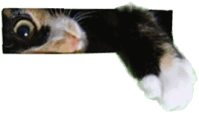Thinking outside the box.
So why has your cat abandoned her litter tray? The basic reasons are because it's the wrong tray, its in the wrong place, it's not cleaned often enough or the cat associates it with an unpleasant experience. One of the reasons that they make such excellent pets is because cats are very clean animals. So for example if the litter tray is too close to the food bowls, the cat will ignore the tray, and use something which is - in her opinion - more hygenically situated. This problem is one of the simplest to solve. Move the tray. Problem solved? Perhaps not immediately - cats are natural conservatives, and once they have got used to using a place, its hard to break the habit. The best thing to do is to not let the habit form in the first place, which is one reason why soiling needs to be sorted out as quickly as possible. The longer you leave it, the more time and patience the solution will require. If, even after moving, the cat won't come to the tray, try making the tray come to the cat - move the tray to a spot where the cat has urinated (even if it is in the middle of your living room). Make sure that the carpet or the floor is cleaned properly, both because this is healthy in itself, and because we don't want to give the cat any scent reminders that this carpet (or wherever) is a former toilet site. If the cat starts using the litter tray in the middle of the carpet, start moving it towards the edge. Take it in gradual increments, because if you rush the move you and the cat will both be literally back where she started.
That it's in the wrong place may not be the only reason why the cat no longer feels comfortable using her litter tray. It might be that something unpleasant happened while she was there. For example in one case a cat started to soil after the cat's human started catching the cat in the litter tray, and taking the chance to pin her down and administer medication. The cat reacted logically enough. It decided that the litter tray was unsafe, and started urinating somewhere more protected - in this case under the sofa. There may be similar reasons - for example the cat becomes startled by some unexpected noise and associates the litter tray with that noise. Like humans, cats feel particularly vulnerable while using the toilet, and if the tray is located next to something like a washing machine, the cat will be alarmed and unappreciative when the machine suddenly bangs into the spin cycle. Think of a place in the house where the cat can do the human equivalent of sitting down with the daily paper in uninterrupted privacy.
Remember that cats do not like dirty litter, although the degree of tolerance depends on the individual cat. Some cats are very sensitive and if they don't have a very clean litter tray, they will seek virgin territory elsewhere. Other cats actually prefer a slightly soiled tray where their own odour clearly marks the tray as theirs. I have a cat which is quite possessive about her litter tray and becomes highly agitated when anyone else does anything with it - even cleaning it out in her presence puts her into a frenzy. She is an indoor/outdoor cat so nowadays I always choose the time when she is out to clean her litter. She always checks her litter tray as soon as she gets back, and if it's been cleaned up she'll make a point of going into it even if just to scratch around. Cats are individuals and you have to find out by trial and error how your cat likes her litter tray. You'll soon discover if she is really unhappy about it.
The same goes for the type of litter. Some cats will be happy to use whatever is in the tray - others will have preferences amounting to outright demands. If you do not know what your cat prefers, start with a fine clumpable litter. This seems to be tolerated by many cats. It is soft to scratch and lasts longer since the tray can be partially cleaned by removing the clumps, though you do need to do a more thorough cleaning every few days. Do not use ammonia-based cleaners. These smell the same to a cat as old urine, which can make the cat feel that someone else is challenging them for use of the tray. It is also best to avoid heavily scented cleaning agents. Cats have very sensitive noses, and what pleases you might have the opposite effect on the cat. Water with a bit of soap is probably best for cleaning, followed by a soak with very diluted bleach. Make sure you rinse the bleach with water and dry well before putting in fresh litter.

